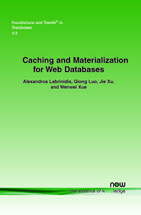Caching and Materialization for Web Databases
By Alexandros Labrinidis, University of Pittsburgh, USA, labrinid@cs.pitt.edu | Qiong Luo, Hong Kong University of Science and Technology, Hong Kong, luo@cse.ust.hk | Jie Xu, University of Pittsburgh, USA, xujie@cs.pitt.edu | Wenwei Xue, Hong Kong University of Science and Technology, Hong Kong, wwxue@cse.ust.hk
Abstract
Database systems have been driving dynamic websites since the early 1990s; nowadays, even seemingly static websites employ a database back-end for personalization and advertising purposes. In order to keep up with the high demand fuelled by the rapid growth of the Internet, a number of caching and materialization techniques have been proposed for web databases over the years. The main goal of these techniques is to improve performance, scalability, and manageability of database-driven dynamic websites, in a way that the quality of data is not compromised. Although caching and materialization are well-understood concepts in the traditional database and networking/operating systems literature, theWeb and web databases bring forth unique characteristics that warrant new techniques and approaches.
In this monograph, we adopt a data management point of view to describe the system architectures of web databases, and analyze the research issues related to caching and materialization in such architectures. We also present the state-of-the-art in caching and materialization for web databases and organize current approaches according to the fundamental questions, namely how to store, how to use, and how to maintain cached/materialized web data. Finally, we associate work in caching and materialization for web databases to similar techniques in other related areas, such as data warehousing, distributed systems, and distributed databases.
Caching and Materialization for Web Databases
Database systems have been driving dynamic web sites since the early 90s, and caching and materialization have been the major techniques to improve the performance, scalability, and manageability of such web databases. Different from a traditional database environment, the software components of a web database, including web servers, database servers, application servers, and possibly additional middleware, are largely independent from one another, even though they work together as a holistic system. Caching and materialization techniques for such web databases consider a number of issues at different parts of the system and they bring interesting challenges and opportunities.
Caching and Materialization for Web Databases adopts a data management point of view to describe the system architectures of web databases, and analyze the research issues related to caching and materialization in such architectures. It also presents the state of the art in caching and materialization for web databases and organizes current approaches according to the fundamental questions, namely how to store, how to use, and how to maintain cached/materialized web data. Finally, it associates work in caching and materialization for web databases to similar techniques in other related areas, such as data warehousing, distributed systems, and distributed databases.
